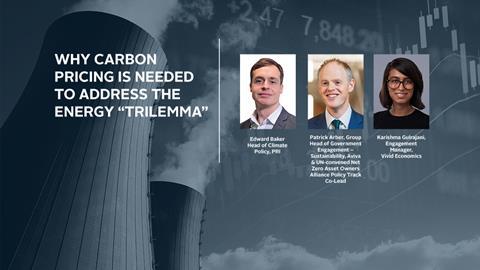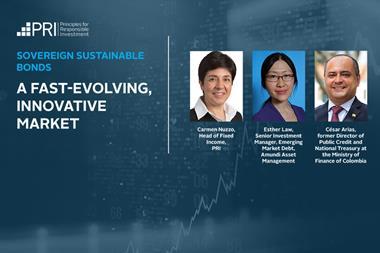Why carbon pricing is needed to address the energy “trilemma”
With Edward Baker, Head of Climate Policy, PRI, Patrick Arber, Group Head of government engagement – Sustainability, Aviva & UN-convened Net Zero Asset Owners Alliance policy track co-lead and Karishma Gulrajani, Engagement manager, Vivid Economics
Note: The Principles for Responsible Investment podcast is designed to be heard. If you are unable to do this, this transcript offers an insight into the episode.
Transcripts are generated using a combination of speech recognition software and human transcribers, and may contain the occasional error. Please check the corresponding audio before quoting in print.
Subscribe to the channel via Apple podcasts, Spotify, or wherever you listen to your podcasts.
Edward Baker
Hello, and welcome to another PRI podcast. My name is Edward Baker, Head of Climate policy at the PRI. Today, we’ll be getting into a new publication from the Net Zero Asset Owner Alliance. Now is a critical time for energy markets, we are a quarter of the way into the decisive decade for addressing climate change and meeting the goals of the Paris agreement, yet investors, businesses and consumers are facing energy price inflation likes of which we’ve not seen in recent memory. And this trillema energy security, affordability, and climate change poses, a sort of a unique set of challenges for policy makers. PRI and also the Net Zero Asset Owner Alliance - we feel that this is a critical time 2 for accelerating the shift to the net zero transition. So what we’d like to do with you over the next 30 minutes or so is talk to you about one of the key tools for achieving this - Carbon pricing. Joining me in this discussion today, I’m delighted to welcome Patrick (Paddy) Arber, who is the head of international governments and engagements at Aviva and co-lead of the UN-convened Net Zero Asset Owners Alliance Policy Track Co-Lead and also Karishma Gulrajani, who is the Engagement manager at Vivid Economics. So Paddy and Karishma, welcome to both of you.
Karishma Gulrajani
Thanks, really good to be here.
Patrick Arber
Thanks very much, Ed. Great to be here.
Edward Baker
Paddy, if I could start with you, if you could briefly talk to us about what we mean by carbon pricing and why is this of interest to asset owners and the members of the Asset Owner Alliance.
Patrick Arber
So, to try and keep it simple and not too technical - carbon pricing is putting a cost on polluting. So currently in most places in the world, if a company pollutes via emitting carbon in one form or another, they don’t have to pay for that. So, it imposes a big cost on society. We all know the consequences of climate change and the way in which that’s already impacting us in terms of extreme weather events, flooding, et cetera, but there’s no one to pay for that cost essentially, or the polluter is not having to pay for it. So, we use forms of carbon pricing, so like taxes or various forms of trading schemes for emissions to impose that cost on the company that’s doing the polluting. The reason that we care about this is that essentially we are looking to make investments that will have a positive effect on climate change.
So we don’t want to make investments that will have a harmful effect on the environment. And we respond to, like all our investors, we respond to price signals. So we look at what the likely impacts are on companies of future events and types of taxation to influence the cost that those companies bear. And so we realised that if forms of carbon pricing are introduced, that will impact the future costs to certain companies and it will change the way that we invest. And secondly, in terms of how Aviva operates, we have quite stringent climate targets. We’ve committed to become a net zero company by 2040. All the Asset Owner Alliance are looking to become net zero by 2050. And that means that we need to see government policies, which create the right kind of economic environment for that to happen. And so that’s why we put such a lot of work into talking to governments about the right kind of policies that we think are needed to accelerate that transition 3 to net zero and reduce carbon emissions and carbon pricing is one of the most important ones to do that.
Edward Baker
We’re sort of in the midst of a profound energy crisis at the moment. And there’s sort of a need for sort of addressing near term pressures as well as this longer structural change. So how can you sort of have a balance of both?
Patrick Arber
There are short term challenges at the moment clearly, but actually this kind of acceleration of the net zero transition is really important, not just for the climate impacts, but also for energy security. So if we’re looking at the energy security implications of continued use of oil and gas to supply much of our energy needs around the world, I think actually a future society, which is lower carbon and relies much more heavily on renewables and forms of energy that can be produced closer to home in many jurisdictions is actually one which is also more secure and which controls these kind of spikes in energy costs that we’re seeing at the moment, you know, largely as a result of external political and difficult events around the world. So, I think that in terms of the tri dilemma that you talk about and that you rightly highlighted at the beginning, the transition to a low carbon future is one that does begin to tackle that. Although we need to be aware that in the short term, we need to look after the impact on individuals around the world.
Edward Baker
Indeed, absolutely. So Karishma, I wonder if I could just turn to you and get your reflections on the role of carbon pricing at this critical juncture to address this energy policy trillema.
Karishma Gulrajani
Completely agree with all of the points that Paddy has just made. I think as someone who grew up in Southern India, which would be on the front lines of climate change, if we were to see two or three degrees rise in temperature, it’s always been very important that climate policy addresses not just mitigation of greenhouse gas emissions, but also ensuring just transition, ensuring economic growth, ensuring energy security. And so it’s vital to deal with all of these priorities at the same time. And I think it can be done. I think carbon pricing is increasingly taking center stage on global discussions on climate policy. We’ve seen just this year, the share of global emissions that are covered by a carbon price increase from somewhere around 15% to about 22%. This is in large part due to China’s new mission trading system coming online, which is massive. It’s the largest system in the world at the moment. We’ve also seen continued improvements in the European systems in the New Zealand emission trading systems in the north American systems. And we’re also seeing and hearing lots of 4 positive considerations and noises about carbon pricing in Indonesia, Brazil, several different developing economies as well.
Edward Baker
That’s great to get that personal perspective that you have, and also just hear about some of these countries worldwide.
Patrick Arber
One thing I was interested in Karishma, as you were talking, you were talking a bit about emissions trading schemes and a bit about taxation. I’ve been interested in understanding a little bit more the differences between those two kind of main types of carbon pricing. So, on the one hand you’ve got taxing emissions and on the other hand, you’ve got trading emissions. And I just wondered, could you explain what the key differences are between those two forms of carbon pricing?
Karishma Gulrajani
Yeah, very happy to carbon taxes and emissions trading systems are the two key types of mechanisms they can both result in equivalent outcomes. One is not better than the other, but the choice sort of depends on preferences and jurisdictional circumstances, really with a carbon tax. What you do is you say, okay, I’m fixing the price per ton of pollution. Every ton of carbon you release into the atmosphere, I’m going to charge you X dollars with an emission stating system. On the other hand, what you do is you fix the total quantity of pollution. That’s allowed by all of the different firms in the jurisdiction or sector or country. And then the firms that do better can sort of trade their excess allowances with firms that need more allowances. This kind of allows more carbon emissions reductions to take place wherever it’s easiest and cheapest. So if I’m a firm that can very easily and cheaply reduce my emission, I’ll do so first and then sell off those extra permits to firms that need more carbon taxes, easier to implement, but you’re never sure whether you’ll achieve that emissions reduction quantity that you need with an emission trading system. It’s a bit more complicated to implement. It takes a while to get going. You might have prices that are a bit less predictable than the carbon tax, but you then know you’re going to definitely reduce a certain amount of emissions. So to kind of sum it up with a tax you share of the price with an emission trading system, you’re sure of the quantity.
Edward Baker
That was pretty good, Karishma. I mean, I think these are complicated ideas and I think that is very helpful to understand these different concepts.
Patrick Arber
Even for me. And I’ve worked in this deal for a long time. It can be quite hard to understand and to explain that difference.
Edward Baker
Paddy, looking at this publication, could you say a little bit more about what the appropriate design principles for governments as they look to implement some of these pricing schemes to meet their net zero goals. Patrick Arber We realise that different governments and different jurisdictions will rightly have specific and unique needs. Having said that we do think there are certain guiding principles that could be applicable in most countries we’ve emphasised five different areas. So the first is that we think governments should look at having appropriate coverage of a carbon price, an ambition. So coverage is which types of emissions are covered by a carbon price. So you don’t want it to be too narrow in the only affect a small sector of emitters. You kind of want it to be as broad as possible so that all the emissions within a country are covered. An ambition is really about how does it match up to the science. So we know that to stay as safe as possible. We want to limit temperature rise to below 1.5 degrees above pre-industrial levels. So that’s the overarching aim of the Paris agreement. Secondly, and this is probably for me personally, one of the most important of the guiding principles. We want a carbon price that ensures what we describe as a, just transition to net zero. And so that means that as we make this transition, we don’t unfairly impact any elements of society or any individuals. And so as a government, if you are raising revenue by introducing a carbon price, so say you are taxing oil and gas companies or utility providers, which might raise costs for individuals. How are we making sure that we are cushioning the impact of that on individuals? For example, do you want to disperse that revenue in a way that protects the most vulnerable people in society or the people who are most impacted? And similarly, if there are certain sectors in a country, so say you’re a country that has traditionally had a lot of coal mining or coal powered utilities, and you’re making a net zero transition, which means that gradually you’re moving away from that form of power to a renewable form.
How are you protecting those people whose jobs and livelihoods are going to be impacted by that a little bit like Karishma’s story earlier about how she’s seen the transition coming from India. For me, I come from the north of England, grew up in the 1980s when a lot of traditional industrial sectors were being downsized. You know, I really saw the impact of that on, on the community around me. And so I think people are now increasingly aware that, yes, we need to have this transition, but we need to make sure that it’s one that doesn’t leave people behind. Third is about predictability of a carbon price. It’s no good. If it just goes up and down, particularly for investors, we’re looking to make long term investments to back the liabilities back, the money that we, we owe people that we’ll need to give back to them at some point.
So we want predictability of, of a carbon price. And we talk in the paper about different ways that that could be achieved. Fourthly, you need a price that minimises competitive distortions. This goes back to the point around. You don’t want to treat one sector or one company differently to its peers. Then fifthly, do we even say fifthly? It’s about promoting international cooperation. So again, if you just have one country or group of countries that have a very high carbon price, and then other countries who have a low carbon price or no carbon price at all, there’s the potential there for essentially you just move all the polluting activity out of one country and into another climate change, doesn’t recognize borders, right? So, if the emissions are just being pushed out to somewhere else in the world, it’s not really having the impact that it needs to have in terms of the overall effect on climate change. And we’re seeing more of this currently in the G7, we talk about that being essential.
Edward Baker
There are tables within the report that kind of really help to visualize this. It was worth just getting into some of these points you’ve mentioned that are so important. This one around just transitions. So, I think there is this view that putting a price on carbon, you know, it’s regressive for consumers. Karishma, could you talk to us about how carbon pricing can be used effectively to support a just transition
Karishma Gulrajani
Carbon pricing is an important part of the policy mix globally, but it’s not the only policy carbon pricing works really well when you have an alternative to switch to. So, for example, it’s worked quite well in moving energy production from coal, which is quite highly polluting to lower polluting forms like natural gas or renewables in some cases. So, it works really well when there’s an alternative where help is needed from other policies is when you don’t have an alternative to switch to, or the alternative is really expensive. So, you need things like research and development investments, grants, and support for innovative technology development to work hand in hand with carbon pricing. Sometimes there’s also, non-economic barriers that need to be considered. So, for example, I may just not like the way an EV works. I may just prefer my old school Chevy. That’s super cool, but still has higher emissions than the EV. So, you need non-price incentives on non-price education as other policies in these areas
Edward Baker
In Europe, in the past, there have been sort of protests around government measures, which have kind of impacted those perhaps with on lower incomes. So, I wonder if one of you could talk a bit 7 about how you can avoid those types of situations and how basically you can take this principle of just transition and design it effectively into carbon pricing policy.
Karishma Gulrajani
So there’s several ways that governments have tried to translate the principle into policy. The main ways of recycling the revenue that’s raised by the carbon price. For example, in the EU at the moment, there’s a, there’s a proposal to implement a carbon price on transport and energy used in buildings. These sectors have direct relevance to our lives on a day to day. And you might see price increases for transport and heating homes, which is particularly relevant in this energy crisis to mitigate the effects of those price rises on the most vulnerable communities. The EU is suggested setting up a social climate fund. So, the revenue that’s raised through this emission trading system is put in this fund, which is used to make investments in energy infrastructure, low carb and transport. And in some cases might even go as direct temporary payments to vulnerable households and communities. We’ve seen this work before in Quebec, in California, for example, a hundred percent of revenues go to a climate fund, which invests in, in mitigation and adaptation measures. So, we’ve seen this principle be used before, but it’s really coming to the forefront now, given the concerns around the energy price crisis, and also trying to really live the principle of just transition.
Edward Baker
Isn’t it fair to say that in the US you’ve had this idea of sort of tax and invest and that’s been something that’s come through in a number of states?
Karishma Gulrajani
Revenue recycling has been particularly successful, I’d say in north America.
Edward Baker
And I think this international pitcher kind of brings on another element and that is if you’ve got carbon pricing in one part of the world, as Paddy was saying that potentially leads to competitive disadvantages for companies. If they’re trying to compete with countries and companies that don’t have those types of carbon pricing mechanisms, Paddy, just to kind of pick up on this fifth point around international measures, he talked to us a bit about the role of carbon pricing, border mechanisms, and also climate clubs.
Patrick Arber
This concept is at quite an early stage, especially in the, in the G7. So essentially my understanding of how it might operate in the G7 is you create a relatively high bar to entry asking the different countries to implement a carbon price, which is aligned with a 1.5 degree Paris trajectory to achieve the aims of the Paris agreement. Those within that club, who’ve set that right level of ambition wouldn’t then be subject to any kind of trade measures between the countries that would
essentially be trying to even out the price in concept. That seems like a, a sensible idea, obviously in practice, you’d have to see how it might work. It would all need to be done within the rules of the world trade organization, even though there’s only seven countries in the G7, it still presents challenges because you have in particular, the us where you might be unlikely to achieve an explicit carbon price, which was as high as it, it would need to be to gain an entry to such a club. So, it may be then that the concept of implicit carbon pricing might come into play. And this was something I was quite interested in this idea of implicit rather than explicit carbon pricing. It wasn’t something that I’d come across before.
Karishma Gulrajani
Would it be useful to just set out some of these terms that we’ve used climate car, carbon leakage, carbon water adjustment. I definitely get lost in the alphabet soup sometimes myself <laugh>
Edward Baker
Yeah, for sure.
Karishma Gulrajani
So essentially a climate club is a concept that’s been floating around economists circles for a long time and it really loosely defined as it can be a group of countries that band together to promote pie ambition in terms of climate policy and emissions reductions members of the club would receive benefits. Those outside of the club would be penalized in some way. One of the ways it’s taking shape is through trade measures. So for example, carbon border adjustments, which is when, if you import goods into a country that has a carbon price from a country that doesn’t have a carbon price, you then pay attacks at the border and that equalizes the playing field. But of course this only looks at the explicit carbon price, as you said. So for example, if you have a carbon tax of X dollars or done, or you have an emission trading at X dollars performance, some other countries have different preferences and different kind of setups here, you might have something like, uh, renewable subsidies, which means that you are effectively providing incentives for decarbonising, but you’re not doing them at a dollar per 10 level.
Edward Baker
One thing that I sort of slightly wonder about this is, isn’t the Paris an agreements or the UNFCCC. So that’s the UN’s overarching body on climate change. Isn’t that some form of a climate club. So how might what’s been discussed in relation to carbon pricing be different to what you already have?
Karishma Gulrajani
I think you could say the Paris agreement is the climate club that we use as a climate club with several kind of nations coming together under one carbon pricing system, with benefits for members and penalties for those outside, especially if you do a carbon border adjustment, but I think what’s new with the G seven thinking of this is to make the benefits a bit more tangible and the penalties a
bit more tangible, particularly through trade, um, because the Paris agreement, while it’s the backbone of international cooperation, it doesn’t have the ability to penalize those outside of it or those that aren’t as ambitious as is needed to reach a 1.5 or, or two degree target.
Patrick Arber
Could I chip in for a moment there as well? Cuz before I worked for Aviva, I used to be a negotiator for the UK government. And so, you know, I was one small part of the UK team negotiating, the Paris agreement. I’m very proud of the Paris Agreement and I think it is a climate club of sorts, but just as Karishma has said, the nature of getting to an agreement among, I think it was 192 countries in the end was that it was very much a kind of a bottom up approach. Countries came up with their own nationally determined contributions i.e. they came up with their own targets and so it wasn’t a top down approach whereby the world and its countries collectively agreed. This is what’s necessary to stay below 1.5 degrees. And this is the right contribution that each member state or each party to the UNFCCC needs to make because that’s fair.
The countries wouldn’t agree to that essentially. So, everybody came up with their own proposal for what they thought was a fair share. And that’s why we are not on track to meet the 1.5 degree trajectory. So, for me, a kind of a new climate club that operated in addition to the UNF triple C, the key element would need to be that ambition element. So, there would need to be a fairly high barrier to entry, which to go back to our guiding principles would need to be having an appropriate level of ambition. So, you would need to be able to prove that what you were proposing to do in terms of carbon pricing and in terms of your overall transition was actually aligned to 1.5 degree, which isn’t the case with how the UNFCCC operates. So, I think it is an, an incredibly important climate club, but there’s also a good argument for why you might want to have other climate clubs that could go further in terms of ambition.
Karishma Gulrajani
And just to illustrate Paddy’s point experts believe that carbon prices need to be in the range $40 to
$80. What down of CO2 in order to meet this Paris aligned trajectory, but at the moment only about 4% of carbon pricing initiatives are at that price level. Of course, countries may choose to meet their climate ambitions through different policies. Like we’ve already discussed. It goes to illustrate how much needs to be done in terms of scaling ambition and climate clubs are one way to do
Edward Baker
That. This is kind of one of the key things that we sort of get to with this publication. So it is sort of building on what’s already there. It’s sort of making a contribution to try and get towards these pricing levels.
If I could just get back to this point about what other policy mechanisms do you think might be needed? You know, we’ve seen, for example, just in Australia, there’s a new government coming in
there. We’re not saying with the type of reporters, you know, they should put in carbon pricing right away. I mean, are there other things that governments should be doing to ensure that there are robust policy frameworks so they can accelerate this structural shift?
Patrick Arber
I can offer a few thoughts on that one, but obviously Karishma has a lot of expertise here as well. I think there does need to be some supplementary measures to carbon pricing. Carbon pricing alone will not deliver the 1.5 degree trajectory. It’s an essential element of that, but it’s not the only element other things that I would mention would include having really good innovation and research policies. As KMA said earlier, it’s a lot easier to make the transition to, to lower carbon forms of energy, where are good alternatives available, those alternatives aren’t available yet. And so that’s where research and innovation policy comes in. We need to develop those and we need to develop them quickly. I think there’s also none price barriers, like lack of information or access to capital for firms that want to create renewable forms of energy. I mean, a big one, something that the G 20 has in theory been committed to for ages, but in practice hasn’t always followed up on, is getting rid of fossil fuel subsidies.
Not only is that not carbon pricing, it’s, it’s having the opposite effect. It’s making polluting cheaper by artificially subsidizing fossil fuel usage. And so I think really important. The G 20 follows up upon its commitments to get rid of fossil fuel subsidies from a financial firm perspective. I think good regulation is also important. This kind of regulatory nudges that have been having in my view, quite a positive impact in the UK and in the EU, the increasing use of climate risk analysis, disclosure, transition planning. So this is a new concept whereby firms are asked to analyse what contribution they’re making to the net zero transition. So all of these have a, have an important part to play. And again, to go back to my earlier point, I think different governments should be looking at what precise policy and regulatory mix they plan to use. And I think they themselves should be coming up with whole of economy, net zero transition plans, where they put out essentially what their plan would be to achieve that net zero transition across their entire economy. And that would include the particular mix of policy and regulatory measures. We think transition planning is essential, not just for individual firms like Aviva, but also for governments and regions as well. Karishma, I’ve probably stolen some of yours as well, but if you’ve got any to add, please do.
Karishma Gulrajani
<laugh> no, I think that sums it up nicely. Paddy, I think essentially climate policy is like an artist palette and carbon pricing is one colour within that. It’s proven to be quite effective in several jurisdictions so far, but it’s not one size fits all. So, countries need to really think about their own circumstances, their own sort of economic mix, their own emission source mix and figure out what’s best for them and kind of use the colours that they think are appropriate. But eventually we all have to work together.
Edward Baker
I think that really helps paint a pitch of their ion up with your closing comments Karishma. This has been really interesting discussion about such an important issue. I would like to thank Paddy and Karishma for talking us through some of the key highlights from this report today. This is something that you can find on the PRI and the UNEP FI website. If you have enjoyed this episode, please do rate and subscribe and go to the PRI’s website for more information. So until next time, goodbye from us.
Downloads
The Principles for Responsible Investment podcast transcript
PDF, Size 0.25 mb



















